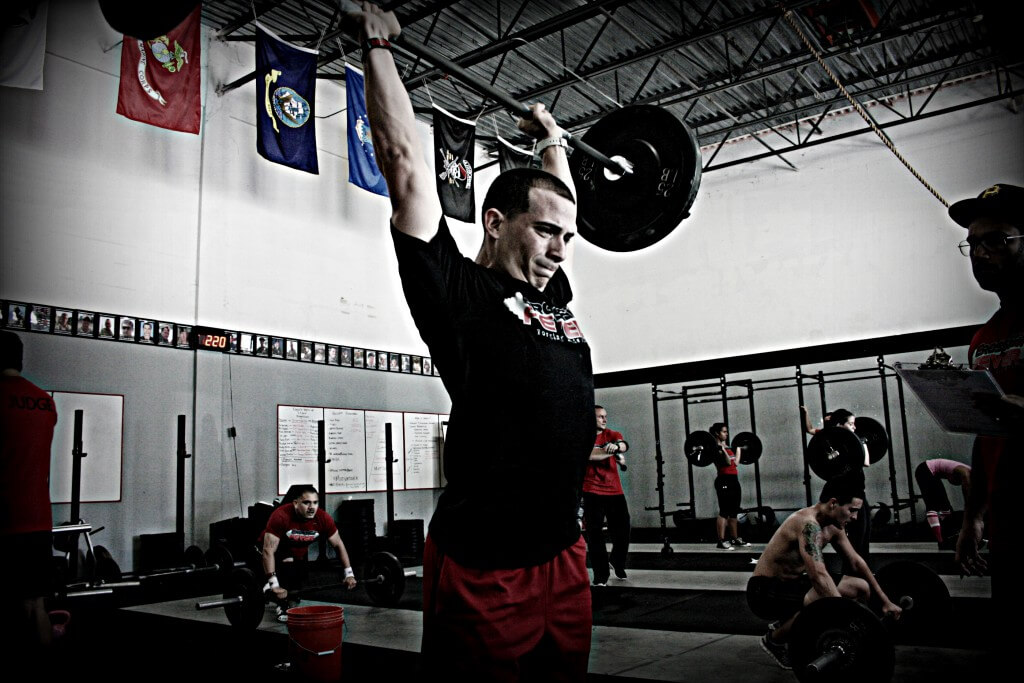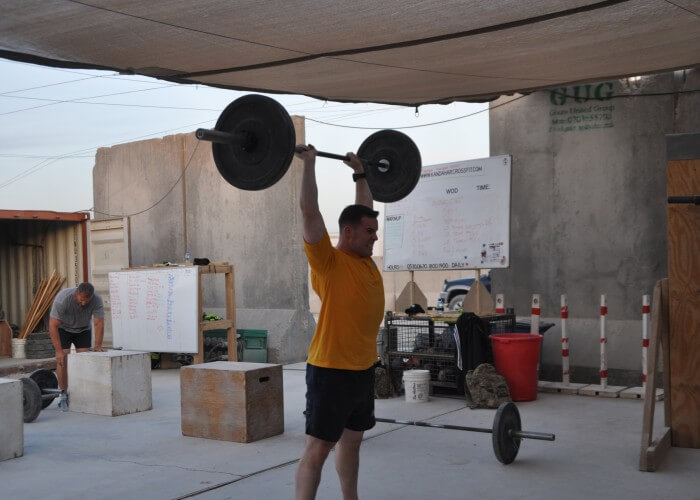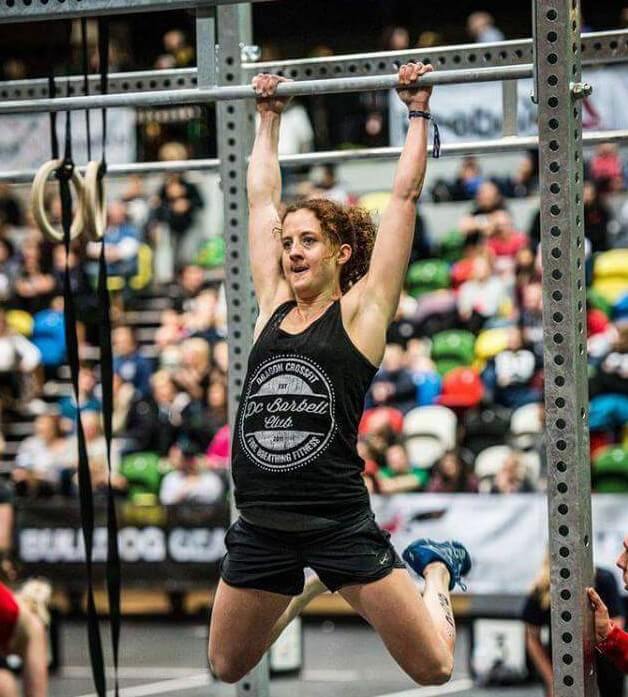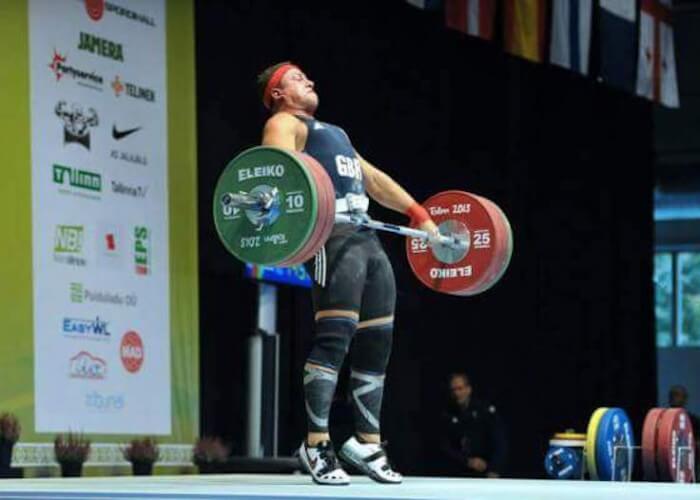Swimming and CrossFit: An Enduring Controversy

By Seren Jones, Swimming World Intern
Originally posted June 2, 2015
It is a universal tradition that as swimmers, we train aerobically to build the endurance needed to perform at an optimal level. According to Dr. Melanie Lang from Edge Hill University, UK, by the age of 14 we swim at least 64k/40 miles a week, which is the equivalent of running 257k/160 miles.
How much yardage must we complete until our bodies become immune to it, until it is no longer beneficial, and we no longer see improvements in results? When is it that we cross the fine line that floats between yardage and the excessive amount of training known as “garbage yardage”? Is it high time that we perhaps steered away from the aerobic foundation of training and toward a more anaerobic base?
Of course, anaerobic training methods have existed and have increasingly developed in swimming over the past decades. Sprint swimming has taken on its own method of training: less yardage, greater intensity, more interval training, more recovery, and so on. Even dry-land training has earned itself a significant role in the sport, by proving that there is more than one way to improve in swimming, not just excessive laps. Many teams today complete at least three dry-land sessions a week on top of their highly demanding pool time.
But can we do more with our dry-land programs? Can we push its concept even further? Is there a certain type of dry-land training that specifically focuses on the sport’s key fitness components of strength, power, and endurance, which could potentially benefit the performance of swimmers?
What about CrossFit?
By now, CrossFit is known as one of the most controversial activities in the sporting industry. CrossFit is a form of exercise that focuses on all fitness components, primarily muscle strength, cardiorespiratory endurance, and power. Although it advocates functional movements and Olympic weightlifting, it is also considered contentious for its reputation of triggering injuries such as shoulder impingement, lower back problems, and knee fragilities.
But before you totally dismiss the idea, know that these injuries are not solely caused by CrossFit. As athletes ourselves, we are aware that injuries occur due to a combination of over-training and poor technique. Thus, the only way you can get yourself really injured, is by rushing through the movements incorrectly with excess weight. It’s like with any other sport, you have to train smart.
When CrossFit is practiced with sound technique, it appears that it actually may complement and correlate with swimming.
Parallels.
Like swimming, CrossFit is a total body exercise where your entire body is working simultaneously and repeatedly for no longer than 20 minutes. This means that instead of working one set of muscle groups at a time, we are working multiple, which is where the parallel between the two sports emerges. Why focus on only strengthening our arms when we can strengthen our arms and legs while engaging our core? Isn’t that what we do when we’re racing?
The intention of CrossFit is to exercise our bodies to such a high intensity and attempt to maintain that intensity for as long as possible. This means working until we physically (and mentally) reach the brink of exhaustion. And even then, we keep going. Isn’t this an experience swimmers are familiar with? The feeling of oxygen debt, lactic acid, and muscle fatigue? Doesn’t this parallel the last 50 meters/yards or 25 meters/yards of a race?
Exercises.
According to Hannah Caldas, a former athlete on the Portuguese National swim team, many Crossfit movements correlate with those of swimming, and can lead to dramatic improvements in the water. Three of which are listed below.
The Thruster is an alternation of a front squat and a push press. Caldas believes that the movement translates its explosiveness into the explosion used to dive from the blocks and push off the wall, as well as providing leg power.
The Kipping Pull Up resembles the butterfly stroke. As well as upper body strength, it requires rhythmic coordination and engaged core stability, including midline and lower back. When the movement is performed correctly and efficiently not only does it provide intense core control, which is an overlooked aspect? in swimming, but it also emphasizes the downward and upward butterfly kick.
The Hang Power Clean is a movement that Caldas states uses multiple muscle groups to work simultaneously. The movement moves the barbell from the hang position to the shoulder level (as though about to front squat) in one swift explosive movement. Even Dan McCarthy, the USA National Swim Team Consultant claims that it may be “the missing piece to many swimmers’ strength and conditioning program.”
“Swimming is the definition of a total body exercise,” McCarthy said. “Numerous muscles and muscle group’s working synergistically to move an athlete through the water. Mimicking a complete swim stroke in the weight room has yet to be accomplished, but forcing the body to execute a movement which requires multiple muscle groups to work together dynamically is as easy as picking up a barbell and performing the Hang Power Clean.”
Sean Allen, coach at Dragon CrossFit Cardiff, also agrees that there is an overlap between the sports.
“As a CrossFit coach, we actively encourage our athletes to vary their training protocols and the demands they place on their body. Swimming, a multi-joint discipline that places high demand on both the aerobic and anaerobic energy systems, is a good fit for CrossFitters as many of the physical attributes required in the water are also applicable to CrossFit, such as coordination, speed, endurance, strength, and so on. Likewise, swimmers would benefit from incorporating low-impact CrossFit workouts into their programming too.”
Perhaps the addition of CrossFit type movements to swimmers’ dry-land programs is worth considering for a number of reasons. Firstly, to increase muscle strength endurance. Secondly, to increase the social cohesion of the group. And finally, to fight the villain of a potentially monotonous routine.







Katlyn Haycock good article to read.
Some very good points. They did leave out the essential component of periodization, the often overlooked piece (within the general Crossft layout) of designing an annual training program for an athlete. Thanks for sharing!!
Very good point! I guess since it is done for me I don’t think about that much! 🙂
Gerard Novello
Ferdinand Cosentino
Sean Gabriel
Dane so swimming again?
Pass!!!
Hahahahah
John Gatfield interesting read ?
Luis Campos A
Laura Gimeno Torres
Ross Johnson. I can see this although I think a lot of people doing crossfit do it without good technique
Irene Adler m’ho mirooo
Laura, worth read… 🙂
Linh D Nguyen
Tom Ford
I just need to transfer my obvious natural crossfit skills into my obvious unnatural swimming efforts…
Willy Baier food for thought
Eoin Foster have a read
Mmmmmm, not sure, might check one out an see what the gig is
Interesting article, although there are several spelling mistakes and grammatical errors, such as:
* When CrossFit is practiced TECHNICALLY CORRECTLY, it appears that it actually may COMPLIMENT and correlate with swimming.
* By now, CrossFit is known as one of the most controversial ACTIVITY in the sporting industry.
Seren, please ask your Editors to proof your copy – this will help improve your journalistic skills! 🙂
I’ll add that picture #1 is a picture of a split jerk, not a thruster, which is what was being referred to in the article.
Unless they’ve already changed the picture, there is no real way to tell if the guy in the picture is doing a thruster, push press, strict press, or push jerk, but he’s definitely not doing a split jerk.
Also, the picture demonstrating a hang clean is actually of a guy doing a snatch, most likely from the floor since it looks like a sanctioned lifting meet.
Not for the first time, and probably not for the last, I may be missing something here. Sport-specificity in training relates just as much to the relevant combinations of to individual muscle groups, their movement patterns and speeds and to the energy systems which supply them, as to the individual components. In both cases the more specific the better.
A particular exercise performed in or designed for a sport (in this case Crossfit) other than swimming may to a greater or lesser degree address swimming conditioning needs. The degree of coincidence will vary both with the exercise itself and in the intensity and frequency with which it is performed in a training programme. But in the end, like any training exercise, it needs to be as specific as possible, optimising the time and effort spent for the performance results required and keeping any deleterious side effects (e.g. superfluous bulk) to a minimum.
Jennifer Stanley
Ally Bazarian!!!
YEA!!!! Read that!!!!
Ben, Mark?
Hi Duncan McCreadie, I think that if used with good planning and done correctly, all types of programme can work. There are examples of purely high volume swimmers delivering great performances and also high anaerobic programmes delivering he same.
The common denominator is belief. Belief in self and belief in what self is committing to.
I also genuinely believe that masters swimmers need strength and power work to promote retention of muscle mass and also promote hormone production.
I could go on as you well know but I’ll stop there mate.
Eitan Yudashkin Guy Moskovich
When swimmers (most importantly coaches) fully understand the need and purpose of Olympic lifting in swimming, the sport will leap to new levels. The ignorance in regards to lifting in swimming just baffles me.
I actually read a research article saying crossfitt makes swimmers slower. Land training should be sport specific. Strength amd conditioning would be a better option to conventional crossfitt.
Haseeb Tariq
Kathryn Louise Cowan